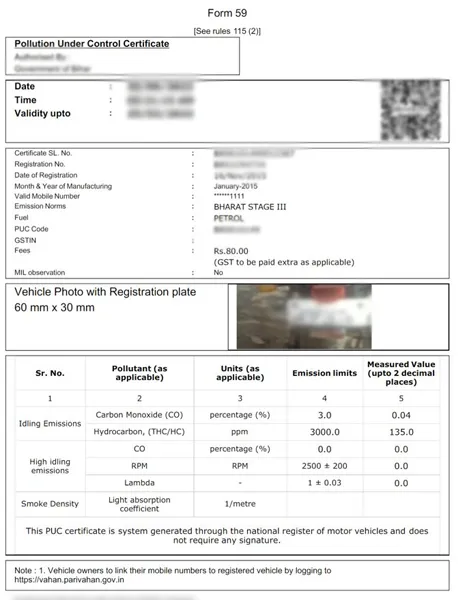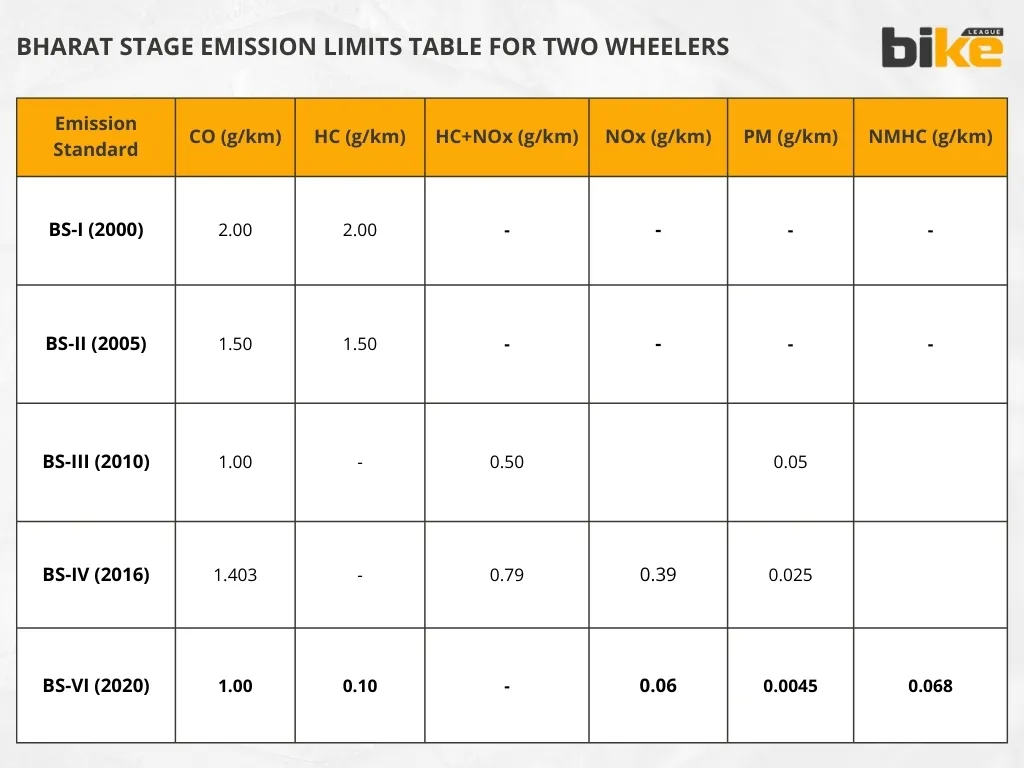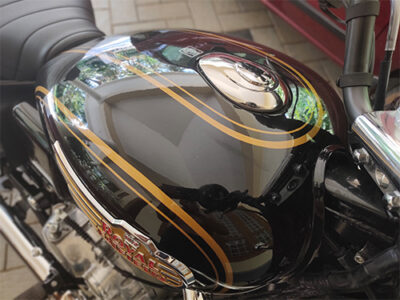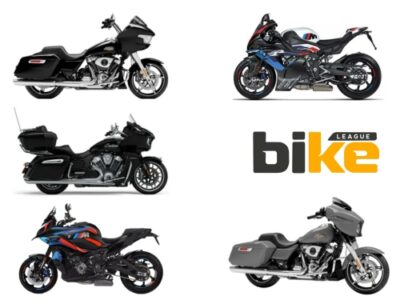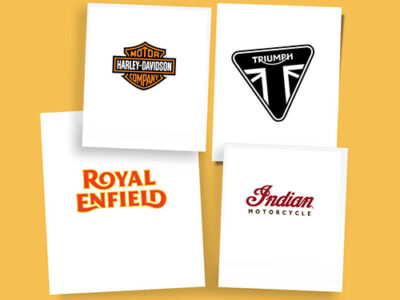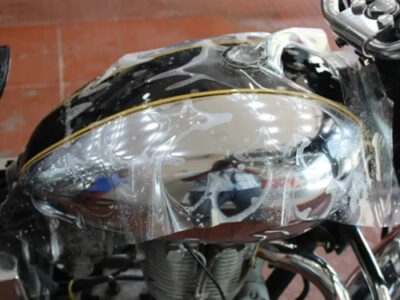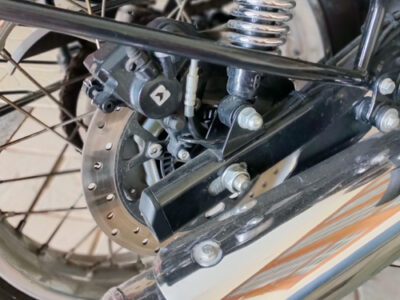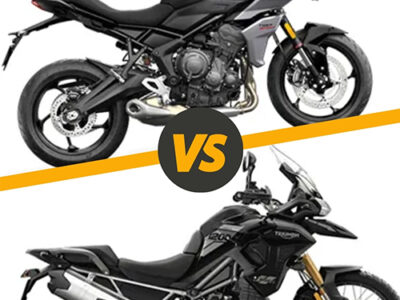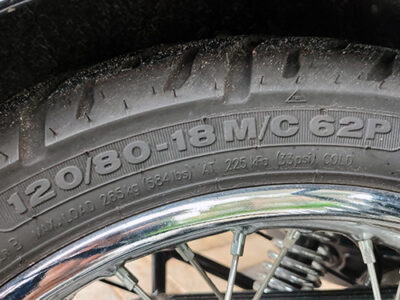
Long story short: Understand the crucial role of the Pollution Under Control (PUC) Certificate and the Bharat Stage emission norms and standards in keeping your two-wheeler compliant with environmental regulations in India.
key takeaways
- A Pollution Under Control (PUC) Certificate is required for all vehicles in India,shows that a vehicle’s emissions meet the pollution control standards set by the government.
- The cost of obtaining a PUC certificate is relatively low, ranging from Rs. 80 to Rs. 100, depending on the type of vehicle and fuel used.
- The validity of a PUC certificate varies based on the vehicle’s age and emission standards. For new vehicles, the certificate is valid for one year from the registration date for all BS stages.Obtaining a PUC certificate is a straightforward process, whether you choose to apply online through the Parivahan portal or visit the nearest emission testing station offline.
- The Bharat Stage (BS) emission standards, a series of regulations set by the Government of India to control air pollutants from internal combustion engines, including motorcycles and scooters.The standards have evolved from BS2 to BS4 and currently BS6.
Introduction
Gone are the days when we could see motorcycles or scooters emitting thick smoke from the exhaust pipes while revving. Now, the times have changed with an ever-increasing number of vehicles, and so are the pollution levels in the major cities in India. One of the main reasons behind this is the emissions from all vehicles, including motorcycles and scooters. One thing is for sure: the government of India cannot limit the number of vehicles, which is out of the equation. The appropriate step is to control the emissions by introducing stricter norms and implementing new technologies within the vehicles.
So, the Government of India has recently jumped from BSIV TO BSVI, considering alarming pollution levels in major cities across India. So everyone can clearly understand the situation right now. Vehicles are increasing daily on our roads. So, this article delves deep into the nuances of the Pollution Under Control (PUC) Certificate and Bharat Stage emission standards and their importance in India. Here, we will also detail what we, as motorcycle or scooter owners, should know about and do environmentally friendly things on Earth. So, let’s start.
What is the Pollution Under Control (PUC) Certificate in India?
A Pollution Under Control (PUC) Certificate is a mandatory document for all vehicles in India, including motorcycles and scooters. It is issued by authorised emission testing centres throughout the country. It validates that a vehicle’s emissions are within the prescribed pollution control norms of the Government of India.
Importance of PUC Certificate in India
The PUC certificate is not just a piece of paper. It’s a crucial tool for ensuring that your vehicle’s emissions are within the permissible limits set by the government. By obtaining and renewing this certificate, you are taking a responsible step towards reducing air pollution and maintaining environmental standards.
Obtaining a PUC Certificate
1. Authorised Centers
PUC certificates are issued by authorised emission testing centres located throughout the country. These centres can be found at gas stations or independent testing facilities. The testing process involves a comprehensive analysis of the exhaust emissions by placing a testing device inside the vehicle’s exhaust pipe. This device measures the levels of pollutants emitted by the vehicle, such as carbon monoxide (CO), hydrocarbons (HC), etc., and compares them to the permissible limits set by the government.
2. Cost
The cost of obtaining a PUC certificate is relatively low, ranging from Rs. 80 to Rs. 100, depending on the type of vehicle and fuel used. This affordability should relieve you, knowing you can easily maintain your vehicle’s compliance without breaking the bank.
3. Online and Offline Methods
Obtaining a PUC certificate is a straightforward process, whether you choose to apply online through the Parivahan portal or visit the nearest emission testing station offline. The online process has been simplified, allowing vehicle owners to download the certificate quickly and conveniently. This ease of access should reassure you that maintaining your vehicle’s compliance is a manageable task.
Validity of Pollution Under Control (PUC) Certificates
The validity of a PUC certificate varies based on the vehicle’s age and emission standards. For new vehicles, the certificate is valid for one year from the registration date for all BS stages. For BS-IV and BS-VI vehicles, the validity period for renewal is one year, while for BS-II and BS-III, it is six months. It is essential to renew the certificate before it expires, and there is a seven-day grace period.
What are the details present in a two-wheeler PUC Certificate?
1. Basic Information
The PUC certificate includes essential details about the vehicle and its owner:
PUC Certificate Registration Number: A unique identifier for the certificate.
Chassis Number: The vehicle’s chassis number is recorded to ensure the certificate is linked to the correct vehicle.
Vehicle Registration Number: This is used to pull up all necessary details about the vehicle during the emission test.
2. Emission Test Results
The certificate contains the results of the emission test, which include:
Emission Levels: The levels of pollutants emitted by the vehicle, such as carbon monoxide (CO), hydrocarbons (HC), etc are measured and recorded.
Permissible Limits: The certificate specifies the permissible emission levels as per Rule 115 (2) of The Motor Vehicles Act, 1988.
3. Validity Period
Initial Validity: The certificate is valid for one year for new vehicles.
Renewal Period: The certificate must be renewed every six months after the first year.
4. Issuing Authority
The certificate is issued by authorised emission testing centres approved by the Pollution Control Board.
Additional Information
PUC Details: The certificate includes detailed information about the emission test and the results.
Vehicle Type and Fuel Type: The type of vehicle (two-wheeler) and the type of fuel it uses (petrol, diesel, etc.) are specified.
What are the penalties for not having a valid PUC certificate in India for two-wheelers
Failing to obtain or renew the PUC certificate on time can lead to significant penalties:
- As of September 2024, the revised fine structure specifies that owners of two-wheelers will have to pay ₹1,000 for the first offence and ₹1,500 for a second violation.
- In some cases, failing to renew the PUC certificate on time can result in a hefty fine of up to ₹10,000 or even imprisonment for up to six months, depending on the offence’s severity and frequency.
- Traffic police have the authority to seize vehicles that do not have a valid PUC certificate or have an expired one.
What is the Bharat Stage (BS) emission standard?
The Bharat Stage (BS) emission standards, a series of regulations set by the Government of India to control air pollutants from internal combustion engines, including motorcycles and scooters, have evolved over the years. These standards have become increasingly stringent, reflecting the government’s commitment to reducing air pollution and protecting the environment. The evolution of these standards is a testament to the continuous efforts of the government to improve air quality and ensure the health and safety of its citizens.
Different types of Bharat Stage (BS) Emission Standards or norms in India
1. BS2 Emission Standards
The BS2 norms were introduced in 2001 and marked a significant step towards reducing vehicular emissions in India. The permissible emission limits for motorcycles and scooters under BS2 are as follows:
Carbon Monoxide (CO): 2.2 g/km
Hydrocarbons + Nitrogen Oxides (HC+NOx): 0.5 g/km
Respirable Suspended Particulate Matter (RSPM): 0.08 g/km
2. BS3 Emission Standards
BS3 norms were first rolled out in 2005 and became mandatory nationwide by 2010. These standards further tightened the emission limits:
Carbon Monoxide (CO): 2.3 g/km
Hydrocarbons (HC): 0.20 g/km
Hydrocarbons + Nitrogen Oxides (HC+NOx): 0.35 g/km
Respirable Suspended Particulate Matter (RSPM): 0.05 g/km
3. BS4 Emission Standards
BS4 norms were implemented nationwide in April 2017. These standards introduced more stringent limits on emissions:
Carbon Monoxide (CO): 1.0 g/km
Hydrocarbons (HC): 0.1 g/km
Hydrocarbons + Nitrogen Oxides (HC+NOx): 0.18 g/km
Respirable Suspended Particulate Matter (RSPM): 0.025 g/km
4. BS6 Emission Standards
BS6 norms were implemented from April 1, 2020, skipping the BS5 stage. These standards are significantly stricter and require advanced technologies to meet the emission limits:
Carbon Monoxide (CO): 1.0 g/km
Hydrocarbons (HC): 0.10 g/km
Nitrogen Oxides (NOx): 0.06 g/km
Non-Methane Hydrocarbons (NMHC): 0.068 g/km
Particulate Matter (PM): 0.0045 g/km

Explanation of Emission Limits in BS emission standards
- Carbon Monoxide (CO): A colourless, odourless gas that is harmful when inhaled in large amounts. It is produced by the incomplete combustion of fuel.
- Hydrocarbons (HC): Organic compounds contribute to smog formation and harm human health.
- Hydrocarbons + Nitrogen Oxides (HC+NOx): A combination of hydrocarbons and nitrogen oxides contributes to ground-level ozone and smog formation.
- Nitrogen Oxides (NOx): Gases that contribute to the formation of smog and acid rain and can cause respiratory problems.
- Non-methane hydrocarbons (NMHC): Hydrocarbons, excluding methane, significantly contribute to ozone formation.
- Particulate Matter (PM): Tiny particles that can penetrate the respiratory system and cause health issues.
- Respirable Suspended Particulate Matter (RSPM): Small particles can be inhaled and cause respiratory problems.
Testing Processes for Different Two-Wheeler Types in India
The emission testing process for two-wheelers in India is primarily governed by the Pollution Under Control (PUC) certification program. But the thing here is that the process is the same for all sorts of two-wheelers, irrespective of engine size, type, etc. There are certain emissions limits under each Bharat Stage norms, and each bike or scooter must comply. So, basically, the process is the same for all two-wheelers in India.
What steps can two-wheeler owners take if they fail the emission test?
If your two-wheeler fails the emission test, take the following immediate steps:
- Request a detailed report of the test results to understand which pollutants exceeded the limits.
- Seek professional help to diagnose and address the issues causing high emissions.
- Schedule the required repairs or maintenance based on the mechanic’s assessment.
- After addressing the issues, have your vehicle re-tested to obtain a valid Pollution Under Control (PUC) certificate.
Technological improvements in motorcycles & scooters across BS emission standards
BS4 Technologies
Motorcycles and scooters complying with BS4 standards typically employ simpler engine technologies, such as carburettors and older emission control systems. The focus was primarily on meeting the emission norms rather than optimising fuel consumption.
BS6 Technologies
The transition to BS6 norms required manufacturers to adopt more sophisticated technologies, including:
Fuel Injection Systems: These are for precise fuel delivery and better combustion.
Advanced Engine Management Systems: To optimise engine performance and reduce emissions.
Enhanced Catalytic Converters: To effectively reduce harmful pollutants.
Impact on fuel and costs across BS emission standards
Fuel Quality
BS6 engines use a significantly lower sulphur content (10 PPM) than BS4 fuel (50 PPM). This reduction in sulphur content helps reduce harmful emissions and pollutants.
Manufacturing Costs
Implementing advanced technologies in BS6 vehicles has increased manufacturing costs, resulting in a price hike for consumers. However, these advancements also contribute to better fuel efficiency and reduced emissions.
FAQ about PUC certificate and BS emission standards
1. Can we obtain a PUC certificate online?
No, PUC cannot be obtained online. You need to take the vehicle physically and test it. After that, a certificate can be downloaded from the Parivahan website if required.
2. Do I need to obtain a pollution certificate for a new motorcycle?
Yes, you need a PUC Certificate for your new motorcycle. When you buy the vehicle, the motorcycle dealer typically provides the pollution certificate, which is valid for one year.
3. Which website can you download the PUC certificate online in India?
To download the PUC certificate online, visit this website – https://puc.parivahan.gov.in/puc/views/PucCertificate.xhtml.
4. What documents do I need to get my PUC certificate?
Only your vehicle is required. The test centre will use its registration number to find everything else it needs.
5. How to Find RTO-approved PUC Centres?
Visit this link https://puc.parivahan.gov.in/puc/views/PUCCenterList.xhtml to find the RTO-approved PUC Centres in India.
6. Should we carry the PUC certificate while driving the motorcycle?
You must carry a copy of the PUC Certificate (soft or hard copy) while driving the vehicle. You can get a fine for failing to produce the PUC Certificate during a general inspection.
7. What are the costs for the PUC certificate for motorcycles and the renewal period for BSII and BSI for motorcycles?
The cost of the PUC certificate for BSII and BSIII is Rs 80. The renewal period is 6 months.
8. What are the costs for the PUC certificate for BS IV & BSVI for motorcycles and the renewal period?
The PUC certificate for BS IV costs Rs 80, and for BSVI, it costs Rs 100. The renewal period is 1 year for both.
9. Which type of motorcycles and scooters need a PUC certificate?
All motor vehicles with internal combustion engines need to have a PUC certificate. Electric vehicles are exempt from this requirement as they do not emit pollutants.
10. What happens if my motorcycle or scooter fails the PUC test?
You need to fix the problems with your vehicle and then re-take the test.
11. What are the penalties for not having a valid PUC certificate?
Not having a valid PUC certificate can result in significant fines. The penalty for the first offence is Rs. 1,000, which increases to Rs. 2,000 for subsequent violations. Please note that these rates change depending on the state where you reside.
12. Why were there no Bharat Stage 5 emission norms in India?
The main reason was that The Government of India has noticed rising pollution, especially in the metros, over the years. As it took over a decade to launch BS4 in the country, the government decided to skip one emission norm (BS5). The Indian government gave ample time to fix the issues and develop new engines for the norms BS6, which are drastically lower than previous BS4 emission norms.
Important official links for PUC Certificate & bharat stage norms in India
Other related articles for pollution under control certificate & Bharat Stage norms in India
- The dos and don’ts of bike modification & traffic rules in India
- Understanding bike insurance jargons & Essential Addons
- Motorcycle RC book in India: Exploring Book vs Digital
- What all basic motorcycle accessories should a rider have
- Things to know while buying second hand motorcycle
Conclusion
If you have any other doubts or queries about the PUC certificate in India or Bharat stage emission norms or standards, email us at bikeleague2017@gmail.com or share your doubts or opinions in the comments section below. We are always eager to help and assist you. Also, here are several social media platforms of Bikeleague India to raise your suspicions.

